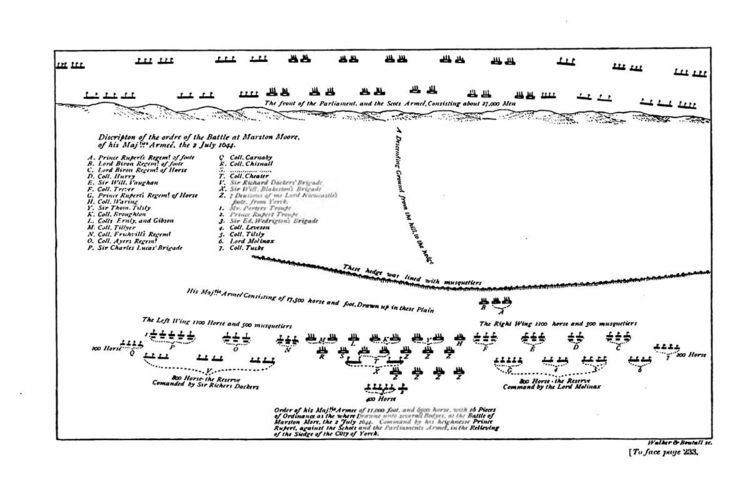 | ||
This is the order of battle of the armies which fought on 2 July 1644 at the Battle of Marston Moor.
Contents
Army of the Solemn League and Covenant
(2000 Horse, 500 Dragoons, 11000 Foot, 50+ guns)
General Alexander Leslie, Earl of Leven (also Commander in Chief of the Army of Both Kingdoms) Lieutenant General of the Horse Sir David Leslie Right Wing Earl of Leven's Regiment (8 troops. Colonel Alexander Leslie, Earl of Balgonie (Leven's son) commanding) Earl of Dalhousie's Regiment (7 troops) Earl of Eglinton's Regiment (7 troops) Dragoons Lieutenant General of the Foot William Baillie Sergeant Major General of the Foot Sir James Lumsden General of the Ordnance Sir Alexander Hamilton (Not all the guns listed below would have been present at the battle) 8 brass demi-cannons 1 brass culverin 3 brass quarter-cannons 9 iron demi-culverins 48 brass demi-culverins Almost all the senior officers of the Covenanter army had experience in the Thirty Years' War. Many of the regiments had served during the Bishops' Wars in Scotland (1639-1641) and the Irish Rebellion of 1641. The infantry was thus a mix of experience, with new and old regiments both containing officers and men with continental experience. Those with siege experience had been left investing Newcastle under a veteran of Dutch service, Lieutenant General the Earl of Callandar. The cavalry used smaller and lighter mounts than English units. Those on the left wing were placed in the rear of Cromwell's horse; on the right, Eglinton's horse were alongside Fairfax's regiment in the front rank and Leven's and Dalhousie's regiments in the rear.Parliamentarian Army of the Eastern Association
(3000 Horse, 4000 Foot)
Captain General Earl of Manchester Lieutenant General of the Horse Oliver Cromwell Commissary General Bartholomew Vermuyden Earl of Manchester's Regiment (Lieutenant Colonel Algernon Sidney: 11 troops) Lieutenant General Cromwell's Regiment (Lieutenant Colonel Edward Whalley: 14 troops) Commissary General Bartholomew Vermuyden's Regiment (5 troops) Charles Fleetwood's Regiment (6 troops) Dragoons Sergeant-Major General of the Foot Lawrence Crawford Earl of Manchester's Regiment (Lieutenant Colonel Clifton: 18 companies) This army was raised in the Eastern Counties of England (Norfolk, Suffolk, Essex, Cambridgeshire and Huntingdonshire). Although there were religious tensions within the army between the Independents, championed by Cromwell, and the Presbyterians who were backed by Manchester and Crawford, there was no argument on the day of battle.Parliamentarian Army of Ferdinando, Lord Fairfax
(2000 Horse, 2000 Foot)
General Lord Fairfax Lieutenant General Sir Thomas Fairfax Sergeant-Major General of the Horse John Lambert Lord Fairfax's Regiment Sir Thomas Fairfax's Regiment Charles Fairfax's Regiment Sir Hugh Bethell's Regiment John Lambert's Regiment Lionel Copley's Regiment Francis Boynton's Regiment Sir Thomas Norcliff's Regiment George Dodding's Regiment Dragoons Sergeant-Major General of Foot (unknown) Lord Fairfax's Regiment John Bright's Regiment Sir William Constable's Regiment Francis Lascelles's Regiment Robert Overton's Regiment Ralph Ashton's Regiment George Doddington's Regiment Alexander Rigby's Regiment The list of Colonels and regiments is probably incomplete. It is evident that most regiments were very weak. The troops present at Marston Moor had a high proportion of recent recruits.Royalist Army
(2500 Horse, 7750 Foot, 14 guns)
General Prince Rupert of the Rhine Lieutenant General Lord Byron Sergeant Major General of Horse Sir John Urry (changed sides shortly after the battle) Prince Rupert's Lifeguard (140) Prince Rupert's Regiment (500) Dragoons Sergeant-Major General of Foot Henry Tillier (captured) Sir John Girlington's Regiment The hard core of this army was Rupert's own regiments of horse and foot, and a small army under Lord Byron from Cheshire and North Wales. To this had been added English regiments recently returned from Ireland, which were said to be full of Puritan sympathisers, and newly raised units from Lancashire, with other small contingents.Contingent of "Northern Horse"
(3500 Horse, 220 foot)
General of Horse George, Lord Goring Lieutenant General Sir Charles Lucas (captured) Commissary General George Porter (captured) Newcastle's cavalry escaped from York shortly after the start of the siege and moved through Derbyshire to link up with Rupert near Bury in Lancashire. The "Northern Horse" already had a reputation for hard fighting but poor discipline. There were too many weak regiments of horse and commanders to list separately; also, it is not certain whether any given regiment was present at Marston Moor, or was elsewhere (with a force under Colonel Clavering, or in various garrisons). At Marston Moor, Newcastle's cavalry were organised as:Derbyshire contingent
When Goring marched to join Rupert in Lancashire, he picked up a contingent from Derbyshire en route.Garrison of York (part)
(number of horse unknown, 3,000 Foot)
General Marquess of Newcastle Lieutenant General Lord Eythin Sergeant-Major General Sir Francis Mackworth As with Goring's horse, Newcastle's infantry were from too many weak regiments to list separately. On the battlefield they were formed into seven "divisions". Newcastle's army was mostly raised in Northumberland and Durham and had already endured a siege of ten weeks, with some hard fighting. Three other regiments (of Sir Thomas Glemham, Sir John Belasyse and Sir Henry Slingsby), totalling 1000 men, were left to hold York.References
Marston Moor order of battle Wikipedia(Text) CC BY-SA
